SELECTED DIVING IN WESTERN AUSTRALIA
NOTE: Much of the content on this page is sourced from and copyright of Dive Adventures Australia.
FEATURED SITES:
- Rottnest Island
- Exmouth - Ningaloo, Abrolhos Islands, Rowley Shoals
- Ex-HMAS Swan
- Ex-HMAS Perth
Rottnest Island
A small island situated just off the coast of Perth famous for its snorkelling, diving, surfing and swimming. Rotto', as it is affectionately known by Western Australians, is a popular holiday destination for both locals and visitors. Rottnest is home to some of the world's finest beaches and crystal clear bays. The semi-arid Mediterranean style climate and indigenous flora and fauna of this island, provide the backdrop to a special holiday experience. With over 360 species of fish,around 13 ship wrecks and numerous reefs and coral, diving and snorkelling around Rottnest island is a must. Rottnest Island attracts tourists from all over the world to dive their picturesque waters. Rottnest is arguably one of the finest dive locations in the world.
Attractions:
Rottnest Island is home to some of the finest beaches and bays in the world. With a choice of over 63 sheltered beaches and 20 bays.
The diversity of fish and coral species, and the numerous shipwrecks found around the Island make Rottnest Island a favourite site for divers and snorkelers.
There are thirteen historic shipwrecks found here and many species of tropical fish make their home in and around the numerous reefs. Around 360 species of fish are drawn to the waters off Rottnest by the Leeuwin current and some 20 species of coral are found within the Marine Reserve, which ensures the protection of the marine environment.
Location & Details :
45 minutes by ferry ride or 15 mins by plane from Fremantle. The island is just 11km long and 4.5km at its widest point. Rottnest Island is without question the premier diving location adjacent to Perth. No other Australian capital city can boast such a stunning recreational facility right on its doorstep. With more than 200 individual dive sites to choose from Rottnest offers pristine diving conditions regardless of weather. Torches are recommended for the Rottnest dives with plenty of soft corals and critters to be seen in the large limestone caverns.
Once underwater the diver can experience massive limestone caverns and tunnels interspersed with meadows of seagrass, sponges and soft corals. Warm subtropical currents ensure that the marine environment surrounding Rottnest is one of the richest on earth. The island itself is a rich mosaic of history and culture interspersed with varied recreational activities to ensure an interesting interlude for even the most jaded traveller. The quiet bays and scenic walks offer something for everyone.


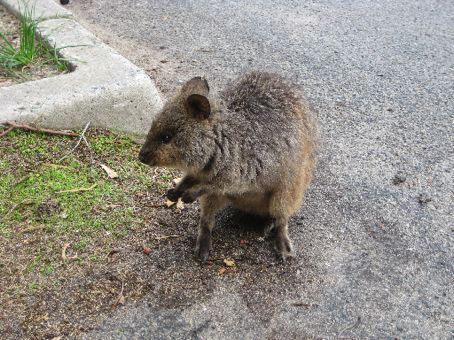



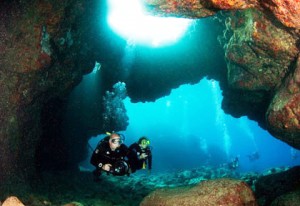
Exmouth
Exmouth was established in 1967 as a communications base for the US Navy. Today it's a small town of about 3,500 people situated just north of the Tropic of Capricorn, about 1,270 km north of Perth. In the early 1990's, the US Navy left leaving the old naval base to the Australian Navy.
Ningaloo Reef is popular for its wide range of other recreational activities including swimming, boating, and watersports such as windsurfing and surfing. Recreational use of coastal headlands, dunes and long white beaches for walking and camping is also a major value of the area.
The nearest airport is Learmonth, just 35 km south of Exmouth. A shuttle bus meets each flight arriving and departing from the airport. Taxis are also available.
Climate:
Exmouth has an average winter temperature of 25 degrees centigrade, while the summer averages 35 degrees. Luckily, Exmouth has no wet season, so the summer days are low in humidity. The water temperature during the months of October to May is 24 C to 28 C. During the winter months from June to September you can expect a temperature of 18C to 23 C.
Scuba Dive Ningaloo Reef
Ningaloo Reef
Along the remote northern coastline of Western Australia's lies Ningaloo Reef. From North to South it stretches some 260 km along the coastline, making it the longest fringing reef in the world. The reef supports a myriad of marine life including over 220 species of colourful coral formations and a huge selection of over 500 species of fish. With the migration of Whale sharks and Humpback whales, Ningaloo reef will excite any avid snorkeler or diver.
Attractions:
During the months of March to July, Ningaloo boasts the biggest congregation of Whale Sharks in the world. Divers and snorkelers alike will be fortunate enough to snorkel with these amazing giants of the sea. The Whale shark's can reach a size of up to 18 meters in length & weighs up to 40,000 kg, these creatures of the deep drift across ocean currents filtering water for the plankton they feed on. As the marine life is quite seasonal, you can expect to see the following during the listed months of the year.
- Whale Sharks: April to July
- Manta Rays: May to November
- Humpback whales: June to late September
- Dugongs: May to August (tend to be quite shy)
- Turtles, sharks, Stingrays & Dolphins: Throughout the year


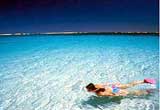
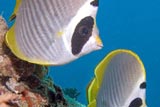
Scuba Diving Around Exmouth
Some popular diving locations:
Muiron Islands
The Muiron Islands are located about 10km north east of Exmouth. Keep your eyes open during the 45 minute trip across to the Islands for ospreys, shearwaters, turtles, manta rays, dolphins, dugongs and, during their migration, humpback whales.
With a maximum depth of 20m and usually gentle currents, the dive sites around the Muiron Islands are suitable for all levels of divers. Swim throughs and ledges provide plenty of places to search for shrimps, nudibranchs, eels, juvenile angelfish and other timid creatures. In mid-water and against the reefs, look for friendly potato cod, large Rankin cod, turtles, nurse sharks, soft coral gardens, anemones, clams and 1000's of darting, colourful reef fish. Late in the year, manta rays grace several dive spots. From about November, the turtles head for the shallow waters of the Islands to mate and nest. On your trip you will spend your lunch break at the beach where you can watch the turtles in the water, see their tracks in the sand and enjoy a fabulous drift snorkel over lively corals.
Point Murat Navy Pier
The Navy pier was built in the 1960's as a supply route for the US. It has since become a dive site with a world wide reputation for its amazing range of sea creatures. Diving under the Point Murat Navy Pier is an experience that all divers visiting Exmouth should undertake. Rated as one of the top dive sites in Australia, the Navy Pier provides the ultimate diving experience.
The 300 meter long Navy Pier is a great fish dive and the perfect complement to your Ningaloo Reef diving itinerary. The variety of marine life under the Navy Pier is just amazing: You will find Wobbegong sharks, white tip reef sharks, large cods and gropers, lion fish, angler fish, stone fish, scorpion fish, frog fish, moray eels, octopus and schools of trevally and barracuda. Most dive operators arrange a single Pier every day - the exact times vary with the tides. The Navy Pier in Exmouth is done as a shore dive; there is no boat access. The entry may be from the platform or from the beach depending on the work schedule for repairs and upgrades to the Navy Pier structure itself.
The Navy Pier is conducted as a group dive with an experienced, knowledgeable dive guide leading. Groups are a maximum of 8 divers per guide during the day and there will be a maximum of two groups on any dive.

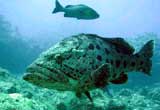


Abrolhos Islands
The Abrolhos Islands lie about 60 kilometres west of Geraldton, on the Western Australian coast, and consist of 122 islands clustered into three main groups: the Wallabi Group, Easter Group and Pelsaert Group, which extend from north to south across 100 kilometres of ocean.
The area is home to an abundance of wildlife including sea lions, dolphins, migratory whales and sea birds. The extensive coral reef system stretches for a hundred kilometres and is home to many species. The unique wildlife and pristine beaches make for excellent swimming, snorkelling and beach walking. The Abrolhos Islands provide idyllic surroundings for a quiet picnic on the beach, or an afternoon snorkelling over coral gardens just under the surface.
The warm south flowing current creates a marine environment that breeds both tropical and temperate sea life. The current maintains water temperatures at about 20 - 22 degrees allowing corals, sea grasses, tropical fish and other sea life to thrive. The Abrolhos are also famous for their historic shipwrecks, the best known being the Dutch East India Company vessel Batavia, which ran aground in 1629. The water surrounding the islands is the graveyard to 18 other wrecks, mostly believed to be from the 19th century.


Rowley Shoals
Just over 180 nautical miles west of Broome, lays The Rowley Shoals, a chain of three spectacular, pristine coral atolls, Mermaid Reef, Clerke Reef and Imperious Reef. Perched on the edge of Australia's continental shelf, the shoals cover 80 square kilometres and rise up to 400 meters from the ocean floor.
The Rowley Shoals are subjected to a high tidal range, with 4m+ tides, flowing into and out of the reefs. The ebb and flow of large volumes of water has helped to sculpt the reefs into dramatic formations. The Shoals support more than 600 species of fish, hump-back whales, manta rays, hammerhead sharks and other large reef species, and more than 200 species of coral. Due to their remoteness, their pristine condition has been impeccably preserved. So precious and unique are they, that they have been declared a marine reserve.
Experience a diverse array of diving environments including, lagoons, canyons, high speed drift dives, sheer outer reef wall dives. Often touted as "The world’s last great underwater wilderness", The Rowley Shoals offers some of the most remote diving within Australia. Diving expeditions to this pristine location operate several times a year. The best time of year for travel is from October to December.
Wrecks
Albany (HMAS Perth wreck):
The City of Albany is located 409 kilometres from Perth, on the southern coast of Western Australia. The HMAS Perth was scuttled here on the 24th November 2001 as a dive wreck.
The Perth is a 133-metre long guided missile destroyer with a distinguished service record. She came under fire on four occasions during the Vietnam War and remnants of shellfire will be visible to divers on the interpretive dive trail.
A visually impacting dive with much of the ships equipment and machinery left in place. The growth has surprised everyone. Sponges, mussels, oysters, scallops, cuttlefish, large kingfish, and a plethora of local fish abound.
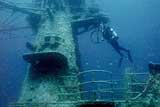

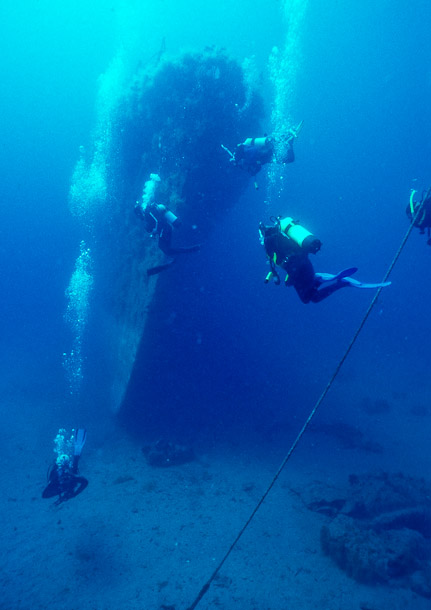

DUNSBOROUGH (HMAS SWAN WRECK):
Dunsborough is located some 225kms South of Perth, approximately 3 hrs. drive. The former HMAS Swan, a 113 metre long decommissioned naval destroyer, was scuttled in December 1997. The Swan has now become a popular dive site; being one of the largest ships in the southern hemisphere to be sunk as a dive wreck.
Large schools of Bulls eye inhabit many rooms, with King George whiting and brim swimming around the hull. The inquisitive Samson fish gives divers an added bonus when looking around the wreck, along with blue devil fish and sweep.